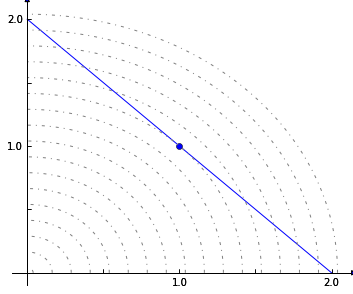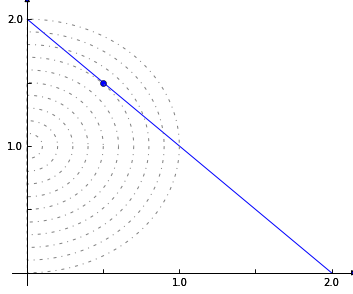8. Quadratic Programming¶
Suppose we want to minimize the Euclidean distance of the solution to the origin while subject to linear constraints. This will require a quadratic objective function. Consider this example problem:
min \(\frac{1}{2}\left(x^2 + y^2 \right)\)
subject to
\(x + y = 2\)
\(x \ge 0\)
\(y \ge 0\)
This problem can be visualized graphically:
In [1]:
%matplotlib inline
import plot_helper
plot_helper.plot_qp1()

The objective can be rewritten as \(\frac{1}{2} v^T \cdot \mathbf Q \cdot v\), where \(v = \left(\begin{matrix} x \\ y\end{matrix} \right)\) and \(\mathbf Q = \left(\begin{matrix} 1 & 0\\ 0 & 1 \end{matrix}\right)\)
The matrix \(\mathbf Q\) can be passed into a cobra model as the quadratic objective.
In [2]:
import scipy
from cobra import Reaction, Metabolite, Model, solvers
The quadratic objective \(\mathbf Q\) should be formatted as a scipy sparse matrix.
In [3]:
Q = scipy.sparse.eye(2).todok()
Q
Out[3]:
<2x2 sparse matrix of type '<class 'numpy.float64'>'
with 2 stored elements in Dictionary Of Keys format>
In this case, the quadratic objective is simply the identity matrix
In [4]:
Q.todense()
Out[4]:
matrix([[ 1., 0.],
[ 0., 1.]])
We need to use a solver that supports quadratic programming, such as gurobi or cplex. If a solver which supports quadratic programming is installed, this function will return its name.
In [5]:
print(solvers.get_solver_name(qp=True))
cplex
In [6]:
c = Metabolite("c")
c._bound = 2
x = Reaction("x")
y = Reaction("y")
x.add_metabolites({c: 1})
y.add_metabolites({c: 1})
m = Model()
m.add_reactions([x, y])
sol = m.optimize(quadratic_component=Q, objective_sense="minimize")
sol.x_dict
Out[6]:
{'x': 1.0, 'y': 1.0}
Suppose we change the problem to have a mixed linear and quadratic objective.
min \(\frac{1}{2}\left(x^2 + y^2 \right) - y\)
subject to
\(x + y = 2\)
\(x \ge 0\)
\(y \ge 0\)
Graphically, this would be
In [7]:
plot_helper.plot_qp2()

QP solvers in cobrapy will combine linear and quadratic coefficients. The linear portion will be obtained from the same objective_coefficient attribute used with LP’s.
In [8]:
y.objective_coefficient = -1
sol = m.optimize(quadratic_component=Q, objective_sense="minimize")
sol.x_dict
Out[8]:
{'x': 0.5, 'y': 1.5}